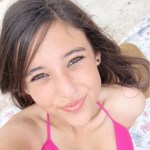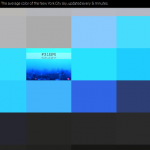Art
YouTube artist and multi-instrumentalist Michael John Blake has been exploring the musical patterns within mathematics, by assigning each note on the major scale a numeral. In this wonderful composition he plays Tau, a number used in a similar way to Pi, for calculating values of circles and whatnot.
Sheril Kirshenbaum has studied why we kiss and what happens biologically. One artist, Natalie Irish, has taken this to a whole new level.
She paints using her lips! Her creative method is demonstrated in this video:
I wonder what's going on biologically as she creates these paintings?
From her website: curious indeed.
To say the least, young Natalie was a child prodigy. Her wizardry in drawing, painting, and sculpture truly showed no bounds. Her transcendent intellect, flowing blonde hair and angelic face simply added to her magnetism as a young artist. Her charm and philanthropic…
Beauty can be everlasting, ephemeral {internet sensations} and above all else, in the eye of the beholder. Poets and artists have explored this mystery for centuries, but can science reveal new insights?
Ed Yong at DiscoverBlogs recently wrote about a fascinating brain imaging study done that begins to address this question, exploring visual and musical stimuli. Yes, beauty can be express itself in many other ways, but this is a start.
Tomohiro Ishizu and Semir Zeki from University College London watched the brains of 21 volunteers as they looked at 30 paintings and listened to 30 musical…
Love can be explosive. This may be a bit much, or it may be just right.
From Molla Space:
War is destructive and bombs take away lives. But these beautifully sculpted ceramic love grenade coin banks are designed and made to plant seeds for future growth and prosperity. Convert your love to change and save it in "A Love Grenade" and donate it to those who are in need.
Part of proceeds benefits Biaugust's cause A.N.S.W.E.R. (Act Now to Stop War & End Racism).
I fully support efforts to promote human rights. This particular example is visually provocative, and raises an interesting…
OK, this is no fair. This is an illustration for an alternative history novel, a book about World War I as fought between biotechnology (Darwinists) vs. industrialists (Clankers).
Now I really want to read Leviathan by Scott Westerfeld. I'm unfamiliar with the author, I have only the vaguest notions about the content of the book, but I just put it on my Amazon wish list for that picture alone.
It looks like I missed my chance — I think this place was only a few blocks from the hotel where I stayed in Brighton a few weeks ago. An artist has put together a montage of 400 casts of women's personal bits, called The Great Wall of Vagina. It's impressive and rather pretty.
You know, I've been planning some research on natural variation in populations, and I've been looking into variation in limb morphology as an easy assay…but man, I'm looking at that and thinking there's an even bigger reservoir of natural varieties right here in the human population. Somebody ought to do a study on…
I am just now recovering from last week's Art of Science Learning conference in San Diego. For something that lasted just one-and-a-half days, there was an almost overwhelming amount of great presentations, great information sharing and exchange, and -- above all -- great people dedicated to moving the idea of the Art of Science Learning forward.
When I first made plans to attend, I did so as an observer. However, soon after the presentations began on the first morning of the conference, I became an active and engaged participant. Each presentation provided me with a deeper understanding of…
Artist Mike Bodge has unveiled a nifty project to chart the colour of the sky above New York City in real time. A camera installed in his office snaps a picture of the skyline every five minutes, and analyses the image to calculate its average colour. The varying shades of blue, grey, orange and black are posted online in a never-ending mosaic.
Mike says:
Many of my projects tend to be about New York City, as it's a place i'm constantly inspired by. I have a great view at my office overlooking the East Village neighborhood and I've done time lapses and other things but none really…
This is a guest post by Prof. Robin Landa, Distinguished Professor, Robert Busch School of Design at Kean University and author of "Advertising by Design: Generating and Designing Creative Ideas Across Media."
Natural movement is a matter of survival for animals. We rely heavily on natural movement to go about our daily lives--whether it is to reach up to place a suitcase in an overhead compartment on an airplane, take a walk, run for a bus, or bend down to retrieve an object. However, few of us, other than dancers and athletes, execute our movements thoughtfully, with more than a nod to…
University College Cork is hosting a small academic event featuring the work of Chicano artists, which includes an art exhibition that includes irreverent images of the Virgin Mary, with titles like "Our Lady and Other Queer Santas". Apparently, this image has stirred up fury and threats from deranged Catholics everywhere it goes — but then, it really doesn't take much to set off mindless fanatics.
Irish Catholic bloggers are outraged and calling for it to be taken down — you aren't allowed to denigrate beliefs, they claim, never mind that yes, you are, and that there isn't anything…
Philosopher and mathematician René Descartes proposed some curious diagrams in 1644. A biologist looking at these shapes might think of living cells under a microscope:
Source.
Compare these shapes to epidermal cells {in this case, the epidermal surface of lamprey larvae. Note that this image is from the wonderful Cell Image Library.)
These designs, also known as "Voronoi diagrams," have found useful applications in a wide range of fields, including medicine such as:
...finding the best location for a hospital based on the locations of surrounding residents can
be obtained by using…
Swim away! Don't antagonize the shark!
You should also be afraid because the ocean is apparently full of literate predators.
I've criticised Western museums for buying or accepting as gifts looted Chinese antiquities. This practice, in my opinion, stems from an outdated and irresponsible fine arts perspective where the exact provenance of a museum piece is not very important. When you're dealing with anonymous prehistoric or early historic art, you can't attribute it to any named artist, and so an art curator will quite happily settle for "Han dynasty, probably the Yellow River area" as a date and a provenance.
As an archaeologist, I do not accept the category "fine art", and I claim precedence for the…
The moon is a rock.
But it's also Selene, Artemis, Diana, Isis, the lunar deities; an eldritch clock by which we measure our growth and fertility; home of an old man in the West and a rabbit in the East; the site of countless imaginary voyages; a long-believed trigger of lunacy (luna...see?). It's another world, close enough to our to peer down at us; to it, we compose sonatas. It can be blue, made of cheese, a harvest moon; we've long fantasized about its dark side, perhaps dotted with black monoliths or inhabited by flying men.
The moon is a totem of great importance in all religions…
The moon entrances us—it is near yet far away, familiar, yet unremittingly mysterious. In synchronous rotation, it has a face it never shows. It pulls the oceans; it stirs the blood. It beckons into the unknown. On Universe, Claire L. Evans says that in 1969, six artists snuck "a minuscule enamel wafer inscribed with six tiny drawings" onto Apollo 12's landing module. Claire writes, "the artistry of this 'museum' is as much about the gesture of sneaking it, illicitly, onto the leg of the lunar lander, as it is about the drawings themselves." On Starts With a Bang!, Ethan Siegel…
You will be entertained by this strange collection of cephalart.
(Warning: there are a few bare breasts in the collection. Wait…molluscs? Breasts? Why do mammals always muddle things up with their mammary obsessions?)
Here's a fun find, courtesy of my buddy Claes Pettersson. As detailed on Jönköping County Museum's blog, a funny little cast-brass trinket came to light during fieldwork at Odensjö ("Odin's Lake"), where recently a very fine Roman era weapon burial has also been unearthed. From a functional point of view it's hard to say what the thing has been used for (no surviving pin arrangements on the back side to identify it as a brooch), but Annika Jeppson's analytical drawing allows us to date it firmly to the Early Viking Period, probably the later 9th century.
Two birds are pecking a round-…
I've reported before [1 - 2] on the on-going discoveries in the Tjust area of NE Småland province. Here Joakim Goldhahn is employing the country's best rock-art surveyors to work through an area that is turning out to be extraordinarily rich and diverse in Bronze Age petroglyphs. These years will be remembered as a time when the Swedish rock art map was redrawn in a dramatic fashion.
Here are two fresh finds from last week, pics courtesy of my friend Roger Wikell. Some of this rock art is pecked on quartzite, a material so hard that Roger compares it to bullet-proof glass. The cool thing…
There are many ways that the Art of Science Learning manifests at our different institutions. This is my
story, and one example of what this can look like.
The concept of art and science integration became a laboratory for two institutions located in San
Francisco, located right across the street from each other. Education staff at the California Academy
of Sciences and the de Young Museum, part of the Fine Arts Museums of San Francisco, explored
the connection of art and science through the similarity between common themes, the process of
development, the way information is conveyed, and the…
We are excited to introduce a new blog dedicated to The Art of Science Learning. This project will culminate in the spring with conferences across the United States. Funded by the National Science Foundation, The Art of Science Learning will explore "how the arts can strengthen STEM skills and spark creativity in the 21st-Century American workforce." Over the coming weeks and months, voices on this blog will "lay out the landscape and articulate many of the issues and challenges we'll be discussing at the conferences." To start things off, David Green suggests we bring science into the…






